分散型ステーブルコインの現状と将来を詳しく解説(前編)
原作者:SCapital
SCapital.fi はアンチシクリカルなオールラウンド ブロックチェーン投資ファンドであり、その事業はビットコイン マイニング、プライマリー マーケットのベンチャー キャピタルをカバーし、市場/業界分析に基づいてセカンダリー マーケットの分散型金融活動にも深く参加しています。
導入:理想的な分散型ステーブルコインは、完全に透明性があり、非保管的であり、第三者による制御がないか制限されている必要があります。集中型ステーブルコインの規模は巨大であるにもかかわらず、規制圧力の増大による検閲に抵抗する必要性は無視できず、一部の集中型ステーブルコインの資産準備金の透明性も疑問視されており、これは明らかに暗号通貨の精神に反しています。したがって、オープンで透明な、完全にオンチェーンの分散型ステーブルコインがますます魅力的になっていくと私たちは考えています。
Background
最初のレベルのタイトル
Statista のデータによると、ステーブルコインの市場価値の総額は約 1,500 億ドルで、仮想通貨の市場価値の総額の約 15% を占めています。その中で、USDT、USDC、BUSD は、暗号通貨の時価総額でそれぞれ 3 位、5 位、7 位を占めています。 CEXの主要取引ペアとして、USDTは先行者利益に依存して仮想通貨市場の総取引高で首位を独占しており、一方でUSDCは2020年のDeFi夏の東風を利用して大きく成長しています。現在のコインはUSDT、BUSDに近いです。BinanceとBSCパブリックチェーンの重要なインフラです。ステーブルコインは、暗号通貨の生態系において不可欠な役割と地位を果たしていることがわかります。
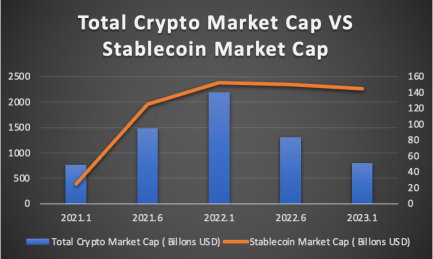
マクロ的な観点から見ると、ステーブルコインの成長に影響を与える最大の要因は市場の流動性によるものであり、連邦準備理事会は2022年も強力な利上げを維持する予定ですが、その結果、仮想通貨市場全体の価値はほぼ直接減少することになります。年初から60%、ステーブルコインの市場価値は2021年と比較するとまだ約2倍となっており、2022年には1500億ドル程度で安定するだろう。将来的には暗号通貨に投資するユーザーが増えるにつれて、ステーブルコインの使用例も増え、ステーブルコインが1兆ドル市場になることが促進されると考えられています。
上記の 3 つのステーブルコインには共通の特徴があります。つまり、これらはすべてオフチェーン事業体の民間企業 (Tether、Circle、Binance) によって発行され、すべて 1:1 法定通貨で準備金を維持しています。これらの集中型ステーブルコインは、規模が巨大ではあるものの、それに伴う課題にも直面しています。
1. たとえば、USDT の準備金は十分に透明ではなく、弱気市場での空売りのベンチマークとなっています。準備金が十分に透明ではない集中型ステーブルコインを使用するには、本質的に、発行者(オフチェーンエンティティの民間企業)が常に1:1の支払い能力を維持するという信頼が必要です。
したがって、このレポートでは分散型ステーブルコインに焦点を当てます。適格な分散型ステーブルコインは、完全に透明で非保管的であり、第三者による管理がないか制限されている必要があります。集中型ステーブルコインに対する規制の圧力が増大し、資産準備金の透明性が欠如しているため、透明で完全にオンチェーンである分散型ステーブルコインがますます魅力的になっていると私たちは考えています。ここでは、分散型ステーブルコインを 2 つの大きなカテゴリに分類します。
副題
Crypto-Collateralized Stablecoins:1. 法定通貨(通常は米ドル)に 1:1 で固定された分散型ステーブルコイン
ibTKNs-Collateralized Stablecoin:ステーブルコインは主に暗号通貨の過剰担保によって生成されます。典型的な例は、DAI、LUSD、crvUSD、Synthetix USD です。その中で、DAI はさまざまな主流の暗号通貨と少量の有利子トークンを担保としてサポートしていますが、LUSD と crvUSD は担保として ETH のみをサポートしており、Synthetix USD のキャスティングは主にプロトコル自体が発行する SNX トークンに依存しています。
Part algorithm, Part crypto-collateralized Stablecoin:FRAXプロトコルは、一部は担保によって裏付けられ、一部はアルゴリズムによって安定化されるという概念を導入しており、住宅ローン比率を信頼度指標とみなすことができ、この柔軟な調整により、過剰担保による資本利用効率不足の問題を効果的に解決できます。
副題
2. 法定通貨に固定されていない分散型浮動ステーブルコイン
最初のレベルのタイトル
Crypto-Collateralized Stablecoins
MakerDao
MakerDao は、イーサリアム ブロックチェーン上に構築された分散型グローバル準備銀行であり、イーサリアム DeFi エコシステムで最も広く使用され、最も長く実行されているプロジェクトの 1 つであり、TVL 最大の DeFi プロジェクトでもあります。 Maker プロトコルは、イーサリアム スマート コントラクトを利用して、米ドルに 1:1 で固定された過剰担保を通じてネイティブの分散型ステーブルコイン DAI を鋳造します。
Basic Mechanism
副題
MakerDaoが最新バージョンにアップグレードされる前は、鋳造された各DAIは、MakerDaoスマートコントラクト内に対応する量のETHを保持しています。これらの契約は、債務担保ポジション (CDP) として知られています。ユーザーは ETH を CDP にロックすることができ、将来的には担保と引き換えに新しい DAI がユーザーにリリースされます。その場合、CDP 内の ETH の価値がリリースされた DAI よりも大きい必要があります。言い換えれば、CDP は超過担保されなければなりません。たとえば、ユーザーが 1,000 ドル相当の ETH をロックアップした場合、CDP 契約では 1,000 ドル未満の価値の DAI が鋳造され、解放される DAI の量は CDP の担保対負債の比率によって異なります。ユーザーは、DAI の担保価値の最大 66% を借りることができます。これは、住宅ローン金利の 150% に相当します。担保の価値がリリースされた DAI トークンの価値と比較して所定の範囲より低い場合、CDP の資産は MakerDao システムの安定性を維持するために裁定取引者によって清算されます。このようにして、Maker プロトコルは、流通しているすべての DAI を裏付けるのに十分な担保があることを保証し、ユーザーがロックされた担保を引き出したい場合は、債務に関連する未払いの安定手数料を含め、CDP で負っている DAI を返済する必要があります。 (利息)。これを行うには、ユーザーは必要な DAI (他の暗号資産ではない) を CDP に送信して、債務と安定化手数料をカバーする必要があります。"DAIを生成するためのスマートコントラクトと預金資産、および生成される金利手数料はMaker契約に属します。 MakerDao は現在、wBTC、LINK、Curve、Uniswap LP トークンを受け入れています。
Governance Token “MKR”
副題
MKR には 3 つの機能があります。
ガバナンストークンとして、MKR保有者はMKRを使用してMakerDaoのガバナンスについて投票することができ、通常ユーザーが投票する内部パラメータには、担保価値の清算比率とDAI生成/清算比率、清算ペナルティ金額比率、清算ペナルティ、DSRデポジットが含まれます。金利DAI貯蓄率、オークションメカニズムパラメータ(約定金額、入札時間、約定間隔など)、どの暗号化資産を担保として使用できるか、オラクルノードの選択など。
MKR は Maker プロトコルの資本増強の源として機能し、通常は借り手にとって最後の手段となります。 Maker プロトコル バッファー プール (Maker Buffer) に債務不足がある場合、システムは債務返済資金を得るために追加の MKR を発行します。 Maker プロトコル バッファー プール (Maker Buffer) の資金が一定の金額 (MKR 保有者が指定した金額) を超えると、システムは追加の MKR を発行します。 )、DAIはオークションに出品され、MKRを買い戻して破棄します。
Stability Mechanism
副題
DAI は米ドルに 1:1 でペッグされるように設計されていますが、DAI は依然として市場動向の影響を受け、一定の価格差が生じます。MakerDao は、DAI の預金金利 (DAI 貯蓄率) の概念を導入し、保有するすべてのユーザーがDAI は、市場の需要と供給のバランスをとるために貯蓄収入を自動的に取得できます。DAI を Maker 契約の DSR 契約に入金するだけで済みます。DSR 契約では、ユーザーの最低入金額要件は設定されていません。ユーザーは、一部またはすべての資金を引き出すことができますDSR 契約からいつでも DAI を取得できます。
市場の変化によりDAIの市場価格が目標価格から逸脱した場合、MKR保有者は価格の安定を維持するためにDSRの変更に投票することができます。
1. DAI の市場価格が 1 ドルを超えた場合、MKR 保有者は需要を減らすために DSR を徐々に下げることを選択でき、それによって DAI の市場価格を目標価格の 1 ドルまで下げることができます。
2. DAI の市場価格が 1 ドル未満の場合、MKR 保有者は DSR を段階的に増加させて需要を刺激し、DAI の市場価格を目標価格の 1 ドルまで引き上げることを選択できます。
Peg Stability Module(PSM)
DAI の利息は MakerDao の安定化手数料の収入によって支払われるため、安定化手数料の総合利率は DSR の利率よりも大きくする必要があります。安定化手数料からの収入がDAIのDSRの総支出をカバーするのに十分でない場合、その差額は不良債権として記録され、その差額を補うために追加のMKRが発行され、MKR保有者がリスク負担者となります。将来起こり得るリスクやブラックスワン現象に対抗するためですが、本質的には、DSR 契約による安定した通貨価格はソフトペッグのみを実現できます。
MakerDao がペグ安定性モジュール (PSM) を導入したとき、DAI はより強力な安定性メカニズムを備えています。その後、PSM は価格安定の最も重要な源となりました。
PSM は、ユーザーが DAI に対して USDC (Circle)、USDP (Paxos)、および GUSD (Gemini) を簡単に裁定取引できる、またはその逆を可能にするスマート コントラクトです。 PSM を介したスワップは常に 1:1 です。つまり、1 DAI は常に 1 USDC と等しくなります。
MakerDaoが、DAIを米ドルにリンクさせるための重要なメカニズムとして、法定通貨に裏付けられた集中型のステーブルコインを使用することで、ある程度の分散化を犠牲にしてきたのは事実である。しかしその後、DAIも前例のない発展を遂げ、PSM準備金におけるUSDCの価値は50億米ドルを超えました。しかし、OFACがTornado Cashに対する制裁を発表した後、MakerDaoの野蛮な成長に埋もれていた隠れた危険の種がついに根を張り、プロトコルへの反撃を開始し、コミュニティがMetaDaoの救済への道を開くきっかけにもなった。
副題
DAI清算メカニズム
ユーザーが Vault の担保を引き出したい場合、Vault 所有者は生成された DAI の一部または全額を返済し、DAI が未払いである間累積される安定化手数料を支払わなければなりません。安定手数料は DAI でのみ支払うことができ、DAI を返済して安定手数料を支払った後、Vault 所有者は担保の一部またはすべてをウォレットに戻すことができます。
負債比率(担保対負債比率)が健全な状態に維持されていれば、システムは正常に機能します。ただし、担保の価値が急激に下落し、ユーザーが生成した DAI が Vault が担保に DAI 生成を許可する値より大きい場合、清算プロセスがトリガーされます。清算時には、ユーザーは DAI を返済する必要がなくなり、Maker 契約により、清算された Vault の担保が取り出され、契約内の市場ベースのオークション メカニズムを使用して売却されます。これは担保オークション(担保オークション)と呼ばれ、落札者はDAIに支払い、清算されたVault内の担保を割引価格で購入します。担保オークションを通じて取得された DAI は、清算ペナルティ (清算ペナルティ) を含む Vault 内の負債の返済に使用され、Maker バッファーに送られます。MKR 投票者は、担保の種類ごとに異なる清算ペナルティを設定します。
オークションや安定化手数料で得たDAIがMakerバッファーの上限(MKRガバナンスが定める値)を超えた場合、超過分は余剰オークション(サープラスオークション)を通じて売却されます。余剰オークションでは、入札者は MKR を使用して一定量の DAI を入札し、最も高い入札者が落札します。余剰オークションが終了すると、Maker プロトコルはオークションから取得した MKR を自動的に破棄し、MKR の総供給量を減らします。
Challenges
副題
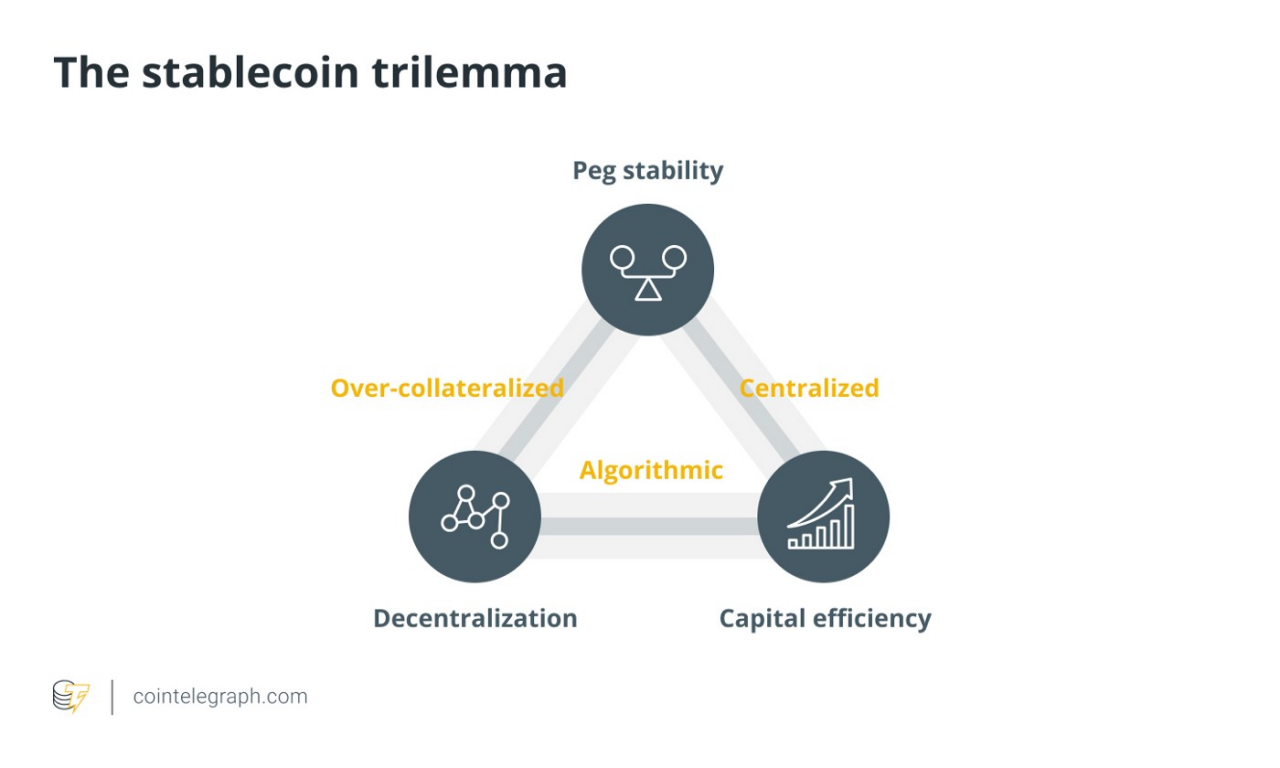
ドル固定の過剰担保は資本利用の効率を阻害する
現時点では、どのステーブルコインもペグの安定性、分散化、資本効率というトリレンマから逃れることはできません。 Maker プロトコルでは、1 つの DAI を鋳造するために担保付き債務ポジション (Maker Vault) を作成するには、1 ドル以上の担保が必要です。つまり、安定性を高めるために資本の利用効率を犠牲にして、DAIを鋳造することは、鋳造されたDAIの価値を超える担保をスマートコントラクトで流通させることができないことを意味します。
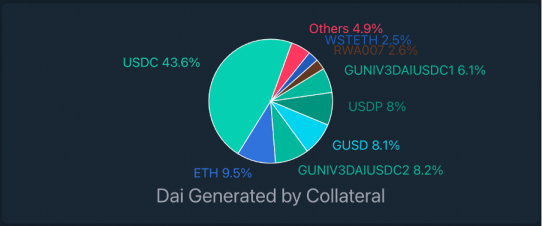
上の図から、MakerDao のエコシステム全体が USDC に大きく依存していることがわかります。これは、鋳造された分散型安定通貨 DAI の 43.6% が Vault 内の USDC モーゲージから来ていることを意味します。 Tornado Cashに対する米国財務省の制裁は、DeFiエコシステム全体が分散型で検閲に耐性があるかどうかについて考えさせるのに十分です。 MakerDaoコミュニティはかつてUSDCの立場を整理し、他のネイティブ暗号通貨に置き換えることを提案しましたが。しかし、DAI と MKR は、USDC のこのような高い市場価値をサポートすることができます。したがって、DAIが真の分散化を達成したいのであれば、USDCがもたらす規模効果を考慮し、DAIの市場価値の急激な下落に対するUSDCの考慮を完全に排除する必要がある。
副題
ガバナンス改革:MetaDAO
一方で、既存のガバナンスプロセスは複雑すぎるため、MakerDao の新機能開発の速度が制限され、他方では、多大な人間の参加に依存する必要があります。エンドゲーム プランの重要な部分として、MetaDAO はガバナンス プロセスの高速化、MakerDao の人件費の削減、リスクの分離、およびこれまで非常に複雑だったガバナンス プロセスのモジュール化に取り組んでいます。
モジュール化の考え方により、複雑な MakerDao ガバナンスは小さな部分、つまり MetaDAO ごとに分割され、各 MetaDAO は他の責任に気を取られることなく、自分自身のタスクに集中できます。たとえば、作成に重点を置く MetaDAO はフロントエンド製品とオンチェーン機能を構築する開発者を募集し、RWA (現実世界の資産) に重点を置く MetaDAO は RWA Vault の管理を担当します。これにより、現在の Maker ガバナンス プロセスのシングルスレッドの問題も克服され、マルチセンター ガバナンスが実現し、MetaDAO の並列実行が可能になり、ガバナンス プロセスが高速化されます。
互いに独立した MetaDAO は独自のガバナンス トークンとガバナンス プロセスを持ち、各 MetaDAO は独自の収入を得る必要があります。最終計画の声明によると、イールド・ファーミングの形で合計20億のMDAOトークンが配布される予定だという。最初の 2 年間で半分が配布され、その後は 2 年ごとに報酬が半分になります。イールド・ファーミングは3つのカテゴリーに分けられます。20%はDAIの需要を奨励するためにDAIファーミングに割り当てられ、40%はステークETHの使用を奨励してDAIを生成するためにETHDファーミングに割り当てられ、40%はアクティブな投票を奨励するためにMKRFarmingに割り当てられます。ガバナンス。
副題
分散化への道
MakerDaoは主に以下の経路を通じて分散度を高め、主に分散型担保の利用を増やし、プロトコル収入を利用してプロトコルが所有する分散型資産を蓄積することに重点を置いています。
1. ETH担保の使用を増やす
Tornado Cashが米国財務省から制裁を受けた後、MakerはUSDCへの依存を減らすために一連の措置を採用した。
たとえば、WSTETH-B Vault の債務上限を引き上げて安定化手数料をゼロに引き下げ、ETH-A、ETH-B、WSTETH-A、WBTC-A、WBTC-B、RENBTC-A、および ETH-A、ETH-B、WSTETH-A、および他の保管庫。
この一連の措置の出発点は、他の Vault の資金調達率を引き下げて、PSM を介して USDC で DAI を鋳造する必要性を最小限に抑えることですが、PSM のハード ペッグ メカニズムは主にユーザーの資金調達を容易にするためのものであるため、実際にはその効果は限定的です。ステーブルコイン間の裁定取引を行う。
2.ETHDの導入
ETHD は、Maker ガバナンスの管理下で自社のステーク ETH に導入されました。 ETHD は、Staked ETH のラッパーです (wstETH と同様)。ユーザーは、ステーキングされた ETH を ETHD にラップしたり、ETHD をステーキングされた ETH に引き換えたりすることができます。
つまり、ETHDは「Staked ETH」を通じて生成される新しい合成資産であり、Makerがより多くの「Staked ETH」を獲得するのに役立ち、Staked ETHの担保を可能な限り蓄積することによってのみ、分散化のステータスが確保されます。その後、プロトコル収益余剰の 90% が ETHD の購入に使用され、プロトコル制御保管庫に保管されます。
3. 現実世界の資産 (RWA) の使用を調整する
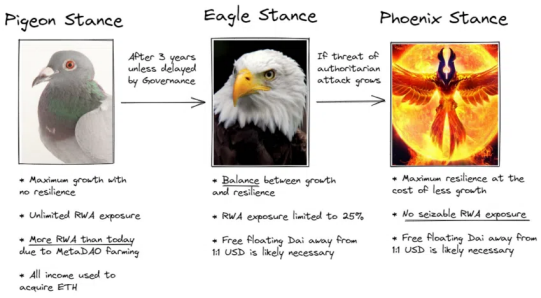
エンドゲームプランでは、ハトフェーズ、ワシフェーズ、ニルヴァーナフェーズという 3 つの異なる付随戦略が提案されており、タイムラインに沿って徐々に発展し、規制の脅威に応じて徐々に前進します。
1 つ目は Pigeon Stance と呼ばれ、基本的に Maker の現在の状態です。このフェーズ(2年半続く予定)中、Makerの主なタスクは、収入の獲得と次のフェーズに向けてETHを保管することに集中するためにRWAを増やすことであり、このフェーズではDAIは1ドルに固定解除されない。
最後に、「ニルヴァーナステージ」(フェニックススタンス)では、DAIは物理的に回復力のある(規制当局によって簡単に没収されない)RWAを除き、いかなるRWAも許可しなくなりました。
Liquity USD
Liquity は分散型、非保管、ガバナンスフリーの融資プロトコルであり、ユーザーは ETH を唯一の担保として使用して無利子ローンを利用できます。ローンは LUSD (米ドルに固定された安定通貨) で支払われます。 110%の最低住宅ローン金利を維持するため。いつでも、原資産に対して額面で償還することができます。
LQTY
LQTYはLiquity社が発行するプロジェクトトークンです。これは、システムによって生成される手数料収入を獲得し、初期のユーザーとフロントエンド ページ開発者にインセンティブを与えるために使用されます。
Trove
Trove は、他のプラットフォームの Vault や CDP と同様に、ユーザーがローンを借りて維持する場所です。 Troves は 2 つの残高を維持します。1 つは担保としての資産 (ETH)、もう 1 つは LUSD 建ての負債です。ユーザーは、担保を追加したり借金を返済したりすることで、それぞれの金額を変更できます。これらの残高が変化すると、それに応じて Trove の担保比率も変化し、ユーザーは借金を全額返済することで、いつでも関連する Trove を閉鎖することができます。
Basic Mechanism
副題
リクイティは常に MakerDao の最強の競争相手とみなされており、両者には多くの類似点があります。たとえば、融資モデルでは資産を信用保証として担保として使用し、米ドルに固定された安定した通貨を生成します。実際、MakerDao の問題点に特化して設計されたメカニズムが数多くあります。
まず第一に、MakerDao やその他の DeFi 融資契約に対する Liquity の主な利点は、最低住宅ローン比率が 110% しかないことです。これは、同じ量の ETH の下でより多くの流動性を解放できることを意味し、より高い資本利用効率を提供します。マルチプルを活用します。
Liquity をより魅力的なもう 1 つのポイントは、無利子ローンです。Liquity は 1 回限りのローン手数料を請求するだけで、MakerDAO のような安定したローン手数料を継続的に請求する必要はありません。料金体系の違いにより、Liquity はよりコスト効率が高くなります。長期ローンの条件。
Liquity は完全な分散化の精神を信じており、ETH を担保として発行された LUSD だけが真の分散化されたステーブルコインであると信じています。実際、MakerDaoは2020年3月以前は担保としてETHのみをサポートしていましたが、312以降のETH価格の急落によりMakerDaoの複数担保サポートの開始が加速され、DAIのモビリティを回復するためのUSDC 1:1交換チャネルが開かれました。上の後日談でもお話しましたが、Makerの「改良」は強気相場におけるDAIの大きな発展を促進しましたが、同時に中央集権化の隠れた危険性の種を蒔くことにもなりました。
Liquity にはガバナンス投票はなく、すべての操作はアルゴリズムによって自動的に実行され、プロトコル パラメーターはコントラクトのデプロイ時に設定されます。債務上限や最低担保比率などのプロトコルパラメータはすべて投票によって決定されるため、MakerDAOではガバナンスが大きな役割を果たします。
清算メカニズムはあらゆる融資システムの安定性の中核ですが、MakerDao と Liquity の清算メカニズムには明らかな違いがあります。
Liquity は、メインネットの立ち上げ直後に 3.12 インシデントを経験したため、多くの分散型ステーブルコインの中で際立っています。LUSD は、MakerDao とは対照的に、この期間に好成績を収めました。根本的な原因は、Liquity の効率的な清算メカニズムにあります。 Liquity は、MakerDao の清算メカニズムのリスクを軽減する自動清算メカニズムを革新しました。
Liquidation Mechanism
副題
1. 安定したプールのメカニズム
安定性プールは、システムの支払い能力を維持するための最初の防御線です。これは、Trove で清算された債務を返済するための流動性の源として機能し、LUSD の総供給量が常に担保によって裏付けられることを保証します。ステーブルプールの資金はLUSDを誓約したユーザーから調達されており、ある程度の流動性は失われますが、インセンティブとしてLQTYトークンを受け取ります。一方、ステーブルプール内のいずれかのTroveが清算されると、Troveの残りの負債に相当するLUSDがステーブルプールの残高から焼かれ、負債が返済されます。その代わりに、この Trove の担保全体が安定プールに移管されます。言い換えれば、LUSDを約束したユーザーはシステム清算から一定量のETH報酬を得ることができ、その額はプール内のLUSDの合計額に対するユーザーの約束したLUSDの比率に関係します。しかし、Troves は 110% 弱の担保比率で清算される可能性が高いため、安定したプール提供者は債務返済に比べてより多くの担保のドル価値を受け取ることになり、これも一部のユーザーにとっては非常に魅力的です。LUSD を鋳造した後、他のトランザクションや DeFi プロトコルでは使用されず、安定したプールに直接預けられます。
2. 再配布メカニズム
安定したプールに十分な流動性がない場合(LUSD が枯渇した場合)、第 2 の防御線、つまり再分配メカニズムがアクティブになります。再分配メカニズムは、清算されたポジションからの残りの負債をすべての既存のポジションに再分配できます。この場合、担保の高いポジションは、担保の低いポジションよりも多くの負債を負い、流動化された資産からより多くの担保を受け取ることになります。この追加のセキュリティ層をシステムに提供するために、これらの上位担保ポジションには清算人として報酬が与えられ、基本的に清算された基本担保を取得します。
第 3 の防御線は、システミック リスクへの対処に焦点を当てています。リクイティではリカバリーモードが導入されています。このモードは、プロトコルの全体的な担保率が 150% を下回るとトリガーされます。そうすることで、システムは担保比率が最も低い安定プールのポジションを (たとえそれが 110% を超えていたとしても) 相殺しようとします。さらに、このシステムは、住宅ローン全体の金利をさらに引き下げる借り手の取引をブロックします。新しい LUSD は、既存の Trove を調整して担保比率を高めるか、担保比率 >= 150% で新しい Trove を開設することによってのみ発行できます。一般に、既存の Trove の調整により担保比率が低下した場合、その結果としての全体の担保比率が 150% を超えた場合にのみ取引が実行されます。
Stability Mechanism
副題
ハードフック機構
Liquity の中核となるイノベーションの 1 つは、そのネイティブのステーブルコインが借り手が保有する基礎的な担保に対して償還可能であることです。これは、LUSD のすべての保有者が額面どおりに LUSD を ETH に交換できることを意味します。つまり、100 USD 相当の ETH を取得するには 100 LUSD を使用します。償還が行われると、システムは LUSD を使用して現時点で最も低い住宅ローン金利で Trove に返済し、対応する量の ETH を影響を受ける Trove から償還者に転送します。
システムでは、償還手数料と呼ばれる、償還ごとに 1 回限りの料金が請求されます。この手数料は 0% から始まり、引き換えのたびに増加し、一定期間引き換えが行われない場合は 0% に減ります。この手数料により、価格安定の観点から必要以上に償還が行われないことが保証されます。
償還メカニズムの存在により、投機家は償還された ETH の価値が償還された LUSD の現在価値よりも高い限り、すぐに裁定収入を得ることができます。これにより、ほとんどの場合、LUSD が 1 ドルを下回ることはありません。
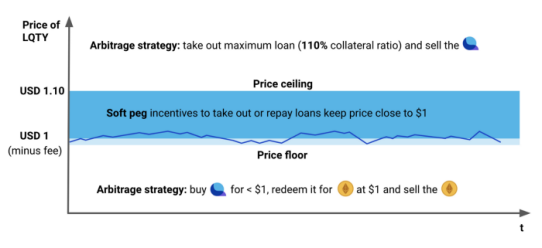
ソフトフック機構
LUSD 価格が 1 ドルを超えると、借入の魅力が高まります (返済が 1 ドル以下で期待できるため)。一方、LUSD 価格が 1 ドルを下回ると、既存の負債の返済が促進されます。 LUSDが返済よりも多く借入されると、LUSDの総供給量が増加し、米ドルに対してLUSDが下落するはずです。逆に、返済額が新規債務よりも高ければ、マネーサプライは縮小し、LUSD は上昇します。
しかし実際には、LUSD は 1 ドルを超えることが多く、ソフトペッグが実際には十分な役割を果たしていないことを示しています。
Challenges
副題
LUSD の現状は初期段階の DAI に似ており、優れた分散性を備えていますが、流通量は十分ではありません。同時に、清算を防ぐためには大量のLUSDが必要となるため、市場変動時にはLUSDの為替レートが常に1ドルよりも高くなり、これがステーブルコインの根本的な問題となっている。当時、DAIはPSMの導入とUSDCとDAIの自由な交換を可能にすることで上記2つの問題を一挙に解決し、前例のない発展を遂げましたが、同時に反検閲や中央集権化といった課題も抱えていました。 LUSD チームが次にどのようなソリューションをもたらしてくれるのか、楽しみに待ちたいと思います。
crvUSD
最初のレベルのタイトル
crvUSDは、よりスムーズな清算アルゴリズムLLAMMAを採用しており、元の過担保ステーブルコインの集中清算における流動性不足によるデススパイラルのリスクを効果的に解決しており、現在、crvUSDは唯一の担保としてETHのみをサポートしており、 USDC のリスク。
副題
清算自動マーケットメイクアルゴリズム (LLAMMA)
crvUSDは依然として過剰担保を通じて発行されています. 簡単に言うと, ETHがcrvUSDの鋳造に使用されるとき, 入金されたETHと生成されたcrvUSDは自動的にLPに結合されます. これらのLPは、従来の融資と清算プロセスを置き換えるために独自のCurve AMMプールにリンクされています。特徴は、清算基準に達した場合、清算が一度だけではなく、継続的に清算/清算解除プロセスが行われることです。これについては以下で詳しく説明します。
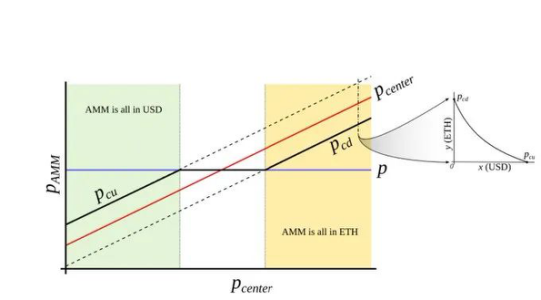
以下の図では、Pamm は関数曲線の価格を表し、Pcenter は外部オラクルの価格を表します。たとえば、ETHを担保としてcrvUSDを借ります。 ETH の価値が十分に高い場合 (黄色の領域)、従来の住宅ローン貸付モデルと同様に、担保は変更されません。 ETHの価格が下落して清算範囲(白い部分)に入ると、ETHの価格下落に伴って徐々に売却され始めました。レンジを下回った(グリーンゾーンに達した)後は、いずれもステーブルコインであり、さらに下落し続けた場合は変動しない点は他の貸付契約と同様です。ただし、中間清算期間でETHが上昇した場合、Curveはステーブルコインを使用してユーザーがETHを再度購入できるようにします。中間清算レンジで変動すると、清算と清算解除のプロセスが継続的に繰り返され、ETHの売買が継続的に行われることになります。
このプロセスは、Uniswap で ETH/USDC 流動性を提供するなど、従来の AMM が流動性を提供した後の一時的な損失をヘッジすることに似ています。 ETHが上昇するとETHは受動的に売却され、流動性を提供する過程で通貨ベースのファンドが急激に変動するのを防ぐため、市場でETHを購入することしかできませんが、同様にETHが下落した場合はヘッジのためにETHを売却します。
したがって、LLAMAの清算メカニズムは、簡単に言うとUniswap V3が逆方向の流動性を提供し、ETHの価格が設定された価格範囲内に収まると徐々にETHを売ってUSDを買うという仕組みだと理解できます。逆も同様で、価格帯の上限を超えると、すべての担保は ETH になり、下限を下回ると、すべての担保は USD になります。
したがって、このアルゴリズムは、極端な市場状況で清算されたユーザーの損失を実際に削減し、価格が回復した後の損失を非常に低い範囲に制御することさえできます。
副題
ペッグキーパーと金融政策
十分な担保があれば、crvUSD の価格は 1 ドルに固定できます。しかし、流通市場での価格は常に変動しており、このときペグキーパーは中央銀行のような存在として役割を果たします。
需要の増加により crvUSD の価格がアンカー価格(ps>1)を上回っている場合、つまり 1 ドルより高い場合、PegKeeper は無担保で crvUSD を鋳造し、一方的に安定通貨取引所プールに預けることができます。 crvUSD価格下落。鋳造プロセスに担保がない場合でも、流動性プール内の流動性が暗黙の担保サポートを提供できます。
crvUSDの価格が1ドルを下回ると、PegKeeperはcrvUSDの流動性の一部を引き出し、価格を1ドルに戻すことができます。
このプロセスにおいて、PegKeeper は、価格が 1 ドルより高い場合は crvUSD を売り、1 ドルより低い場合は crvUSD を購入し、裁定取引を通じて crvUSD の価格安定を維持することに相当します。
金融政策は、PegKeeper の負債と crvUSD の供給との関係を制御します。たとえば、債務/供給が 5% を超える場合、借り手にステーブルコインの借り入れと売却を奨励し、システムに債務を強制的に燃焼させるようにパラメーターが変更される可能性があります。債務/供給が不足すると、借り手にはローンを返済するよう促され、システムが債務を増加させます。
Curve のステーブルコインに関するレイアウトは戦略的に重要であり、ETH を含む暗号化されたネイティブ資産のプレッジによって生成されるステーブルコインは、裏書きとして法定通貨に依存するステーブルコインを徐々に排除し、暗号化市場の反規制能力を強化することができます。そしてさらに重要なことは、DeFiエコシステムは自己修復機能を備えているため、下降強気市場でcrvUSDがどのように機能するかを見守ることです。
副題
SCapitalSキャピタルについて



